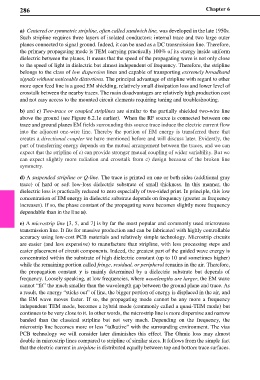Page 306 - Maxwell House
P. 306
286 Chapter 6
a) Centered or symmetric stripline, often called sandwich line, was developed in the late 1950s.
Such stripline requires three layers of isolated conductors: internal trace and two large outer
planes connected to signal ground. Indeed, it can be used as a DC transmission line. Therefore,
the primary propagating mode is TEM carrying practically 100% of its energy inside uniform
dielectric between the planes. It means that the speed of the propagating wave is not only close
to the speed of light in dielectric but almost independent of frequency. Therefore, the stripline
belongs to the class of low dispersion lines and capable of transporting extremely broadband
signals without noticeable distortions. The principal advantage of stripline with regard to other
more open feed line is a good EM shielding, relatively small dissipation loss and lower level of
crosstalk between the nearby traces. The main disadvantages are relatively high production cost
and not easy access to the mounted circuit elements requiring tuning and troubleshooting.
b) and c) Two-trace or coupled striplines are similar to the partially shielded two-wire line
above the ground (see Figure 6.2.1e earlier). When the RF source is connected between one
trace and ground planes EM fields surrounding this source trace induce the electric current flow
into the adjacent one-wire line. Thereby the portion of EM energy is transferred there that
creates a directional coupler we have mentioned before and will discuss later. Evidently, the
part of transferring energy depends on the mutual arrangement between the traces, and we can
expect that the stripline of c) can provide stronger mutual coupling of wider variability. But we
can expect slightly more radiation and crosstalk from c) design because of the broken line
symmetry.
d) A suspended stripline or Q-line. The trace is printed on one or both sides (additional gray
trace) of hard or soft low-loss dielectric substrate of small thickness. In this manner, the
dielectric loss is practically reduced to zero especially of two-sided print. In principle, this low
concentration of EM energy in dielectric substrate depends on frequency (greater as frequency
increases). If so, the phase constant of the propagating wave becomes slightly more frequency
dependable than in the line a).
e) A microstrip line [3, 5, and 7] is by far the most popular and commonly used microwave
transmission line. It fits for massive production and can be fabricated with highly controllable
accuracy using low-cost PCB materials and relatively simple technology. Microstrip circuits
are easier (and less expensive) to manufacture than stripline, with less processing steps and
easier placement of circuit components. Indeed, the greatest part of the guided wave energy is
concentrated within the substrate of high dielectric constant (up to 10 and sometimes higher)
while the remaining portion called fringe, residual, or peripheral remains in the air. Therefore,
the propagation constant is mainly determined by a dielectric substrate but depends of
frequency. Loosely speaking, at low frequencies, where wavelengths are larger, the EM wave
cannot “fit” the much smaller than the wavelength gap between the ground plane and trace. As
a result, the energy “sticks out” of line, the bigger portion of energy is displaced in the air, and
the EM wave moves faster. If so, the propagating mode cannot be any more a frequency
independent TEM mode, becomes a hybrid mode (commonly called a quasi-TEM mode) but
continues to be very close to it. In other words, the microstrip line is more dispersive and narrow
banded than the classical stripline but not very much. Depending on the frequency, the
microstrip line becomes more or less “talkative” with the surrounding environment. The vias
PCB technology we will consider later diminishes this effect. The Ohmic loss may almost
double in microstrip lines compared to stripline of similar sizes. It follows from the simple fact
that the electric current in stripline is distributed equally between top and bottom trace surfaces.

